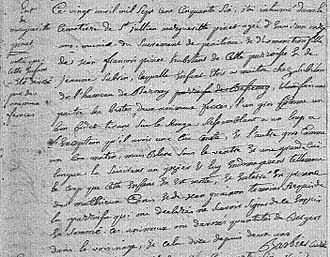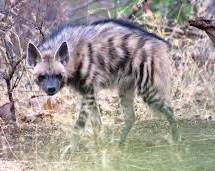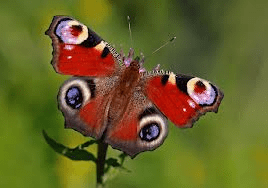The Beast of Lyonnais was yet another killer monster (or monsters) in the long, long series of various creatures, beasts, feral dogs, hybrid dogs, wolves with attitude, sexual psychopath or good old fashioned serial killers who have ravaged different regions of France from around 1550 until the present day, with particular reference to the period 1750-1820.
I will freely confess that I knew nothing whatsoever of this type of event until very recently, when I started reading about the Beast of Gévaudan. Then I realised that there had been a Beast of Benais, a Beast of Auxerrois/Trucy, a Beast of the Cévennes/Gard/Vivarais (it did like to travel about a bit) and then a Beast of Sarlat.
There seemed to be any number of them, and I deliberately selected the ones which seemed not to be the most obvious of wolves. This is also the case with the Beast of Lyonnais, which, as we will see, hardly any of the witnesses at the time thought was good, old canis lupus lupus, even if all the noblemen at the time told them that they were mistaken (despite the fact that none of them had ever seen it):

Once again, I will begin by looking at a number of websites written in French, offering you my own translations and you can then take your own average between them.
We start with a hoary old favourite:
“The Beast of Lyon was a man eating animal behind a series of attacks on humans. The first attack was mentioned as being in the summer of 1754. Until the end of 1756, one or more ferocious beasts then ravaged the countryside, initially between Vienne in Isère, Meyzieu and then around Savigny in the Rhône area. This or these, animals claimed about thirty victims, mostly children or teenagers. Here is Meyzieu:

In early August 1754 the Royal Notary of Vienne was summoned by the most important individuals in the parish of Luzinay to proceed with the identification of the body of a young boy who had been found devoured. We know that at least two other attacks occurred in this same area, around Villette-de-Vienne and Régnié-Durette, before the Marquis of Marcieu, the Governor of the province, ordered a large hunt to trap the beast.
.
The Great Hunt took place on September 10th, 1754 and lasted two days. It mobilized around 2,000 hunters from 26 different villages, but had no effect other than increasing the extent of the predator’s territory. All trace of the Beast was lost in the last three months of 1754.
The beast resurfaced in February 1755 in the parish of Sarcey, where it killed a new victim. Until at least October, at least one death on average per month could be attributed to the creature, mainly around Savigny and L’Arbresle . There was then no more news of the creature during the winter of 1755-1756. Here is Savigny:

On Easter Tuesday, April 20th, 1756, a girl was found devoured in Saint-Julien-sur-Bibost. During this attack, for the first time, witnesses reported two beasts together.
In early 1757, the parish priest at Brietton in the parish of Sourcieux-les-Mines estimated that a total of some 25 people had been attacked in the local area since the Easter of 1755. According to the priest, the (two) creatures were wounding more people than they killed and these victims might equally well have been eaten if nobody had come to their rescue.
On November 24th 1756, the last victim was devoured and left half consumed at Montrottier. The local parish priest was the first to hypothesize that the beast might be a hyena. This hypothesis, which has been challenged by present day research, was also put forward at the time to explain the Beast of Gévaudan:
This slideshow requires JavaScript.
Following this apparently final attack in November 1756, the parish registers have no further mention of people being devoured by wild beasts in the vicinity of Lyon.
The accounts of burials that we still have give comparatively little information about the animal or animals ravaging the Lyon area between 1754 and 1756. The priest of Saint-Julien-sur-Bibost is the only one to have left us any evidence:
“This April 20th 1756, I buried in the cemetery of St Julien sur Bibost Marguerite Pinet, aged about eleven, the daughter of Jean-François Pinet, a resident of this parish & Jeanne Subrin. The child was employed by Monsieur Subilon in the hamlet of Bernay in the parish of Besenay to watch over his animals in the fields”

“There were two ferocious animals, one as big as a small horse, reddish in colour, resembling a wolf, except that it had a short tail. The second animal was as big as a good sized mastiff, but it had white on the belly and a great long tail ; they seized Marguerite by the throat and neck causing enough damage to kill the child; she was buried in the presence of Mathieu Crois and Jean Guainon , witnesses required by the parish, who said they were illiterate and could not sign this form. These animals have devoured a good number of shepherds in the area. This has gone on for two years. Berbier, Priest.”
Here is a shepherdess, the meal of choice for the majority of monsters and beasts during this era. The sheep were usually ignored:

The descriptions of the time mentioned a wolf, but with shorter legs. The fur was more coarse and the skin was mottled with several different colours. The evidence of the priest at Montrottier was that rumours of a hyena had currently gained momentum.
The theory of a werewolf was equally popular at that time and was mentioned by the Marquis of Marcieu in his instructions for Great Hunt held on September 10th, 1754:
“The Officers of both the Fusiliers and the Trackers must make every effort to destroy the ordinary people’s fanatical belief in werewolves:

We must prove to them that these are just ordinary wolves which unfortunately are accustomed to eating human flesh.
Even if the woods are full of lynxes, bears and tigers, we must prove to them that these are just animals which a bullet from a rifle will kill, and which it is necessary to destroy.”
The French word “loup-cervier” appears on a number of occasions connected with these mystery monsters. I have found it impossible to trace the word in the Online dictionary which I normally use,
but Google Images for France provides any number of photographs of lynxes, mostly Canadian lynxes but also European ones. I eventually discovered that “loup-cervier” originally meant a lynx which hunts stags, and is used nowadays as a favourite metaphor for predatory financiers. “Cervier” seems to have no real existence except when attached to the word “loup” or very occasionally “chat”.
In any case, a Lynx, whether European or Canadian, is more or less out of the question as regards the Beast of Lyonnais. Lynxes are unbelievably shy and retiring creatures and it is inconceivable that they would attack human beings. In Europe their favourite prey item is Roe Deer. This is a European Lynx:

In North America, they hunt mainly Snowshoe Hares. This is a Canadian Lynx, the so-called “loup-curvier”:

To me, they are more kute than killer:
This slideshow requires JavaScript.
Wikipedia carried a list of the victims of the Beast(s) of Lyonnais:
Pierre Morel (5 years old), Claudine Tardif (45), François Beloud (8), Madeleine Joubert (?),Christophe Cambria (7), Anne Tricaud (14), Pierre Guillon (10), Marie Berchoud (13), Mathieu Gervais (9), Hélène Berquet (6), Marie Berger(6), Claudine L’Hospital (8), Catherine Cusset (10), an unknown toddler(2), Jean-Marie Duboy (13), Pierre Vaché (8), Benoite Daverdi (9), Marguerite Pinet (11), Benoît Thiver (10), Pierrette Devilard (7), Étienne Manu (6), Pierre Delorme (13), Jean-Baptiste Chazaud (7), Claudine Allioud (8), Anne Tiron (10), Elisabeth Blanc (11), Benoît Mortan (12), Jean Malaval (9), Marie Lombard (10), Benoit Barroh (sic) (1), Claudine Guillot (4), Pierre Paleron (6), Jean-Baptiste Bazin (14) and Anne Sarrazin(9).
This seems to be twice the usually quoted figure of seventeen. The first victim was killed on June 5th 1754 and the last on November 24th 1756. Very roughly, the deaths occurred perhaps once or twice a month, although in some months there were no killings at all. The original list gave dates without any further details but as far as I can ascertain, there were no occasions when two victims might have been killed together. On several occasions, one victim may have been quickly followed by another at the same location, but they were always killed on different days. In some cases, the animal or animals might have returned repeatedly to kill its prey, such as at the village of Savigny (6 slayings), Saint-Pierre-de-Chandieu (3) and Saint-Romain-de-Popey (2). This is Savigny nowadays. It looks a lot quieter:

I just do not know if ordinary wolves would return to the scene of the crime like this, although all predators, both animals and birds, tend to be very much creatures of habit, following the same paths and game trails every single day.
Another familiar website tells a fairly similar tale, but comes to a very different conclusion:
In all, seventeen young men and children were bitten, ripped to pieces or even devoured. Those who saw the animal, or believed they saw it, said that it was approaching the size of a wolf, with shorter legs, a coarser coat and skin mottled with various colours-an exact portrait of a hyena.
From these accounts, people were all agreed that it was a real, genuine hyena. But who is unaware that fear may magnify things, or change them completely. The descriptions that people have given of this carnivorous animal have probably been inspired by their heated imaginations. Fleeing at top speed, how could exact measurements be taken by eye? And running along, the creature must have seemed a lot lower than he really was. The frantic motion of his entire body made his hair stand on end and lastly we know that glare changes shades of colour. Take away these circumstances from your sighting, and instead of a hyena, much more likely it was a question of a big wolf driven by famine in that harsh winter of 1754.
The excessive winter weather of 1754 forced the animals of this latter species to seek in the villages what the countryside could no longer supply to them. Moreover, the hyena is an animal entirely foreign to our climate:

How would he have got to France? Can we suppose with any degree of probability whatsoever that he has crossed the immense expanses which separate us from his native home without leaving behind any traces whatsoever of his journey?
We are forced to conclude that too often we consider something miraculous when it is nothing out of the ordinary. “
Another description was of:
“two ferocious animals, one as big as small horse, verging on red in colour, like a wolf except it had a short tail. The other was the size of a large mastiff, but it had white on its belly and a big long tail”
When I wrote about the Beast of Gévaudan and examined in some detail the solutions to the mystery, I thought that the centuries old puzzle was solved. The Chastel family was the guilty party, and in particular, long and greasy haired Antoine. But then I read about the Beast of Cévennes/Gard/Vivarais whose behaviour was nothing like that of a wolf. And then came the puzzle of the Beast of Benais who the local people actually thought at the time was the “Beast of Gévaudan on Tour”. After that, it was the Beast of Sarlat which was supposedly a rabid wolf, although none of the locals thought so, preferring a werewolf as the likely explanation:

Next came the Beast of Auxerrois/Trucy which was not a wolf, the locals said, but a tiger, a demon or a werewolf.
Throughout my articles, I had deliberately ignored obvious wolves as culprits and deliberately selected only the creatures which seemed to me not to be obvious wolves.
The enduring problem was that there just seemed to be any number of these strange creatures and so many of the “wolf but not a wolf” category. You can’t stretch the Chastel theory to explain away all of them.
Soooooo……..
I have returned to C.R. Rookwood who, in one of his blog posts, suggested that the Beast of Gévaudan, was a prehistoric mammal, a mesonychid, which were very large ancient predators with huge heads, long tails, and hooves instead of feet.
This slideshow requires JavaScript.
I do not have enough scientific knowledge to be quite so precise, but I would certainly go for some kind of relict creature, a fierce animal left over from a bygone age, its ever diminishing population dwindling on in the trackless forests and mountains of south-central Europe. Perhaps it was some kind of hyena such as the Cave Hyena. These photographs give an idea of their size:
This slideshow requires JavaScript.
I said that I did not think these monsters could be wolves, but the “Dire Wolf” is not a wolf. Or at the very least, it is a wolf, Jim, but not as we know it:
This slideshow requires JavaScript.
Who knows? And indeed, who ever will?






































